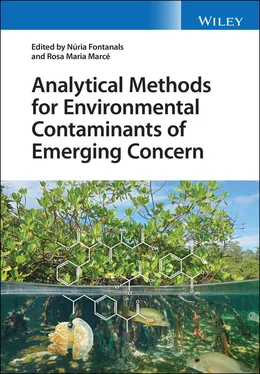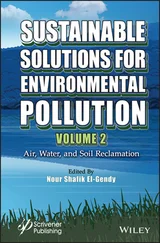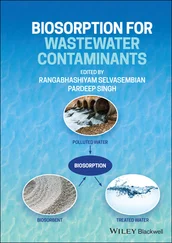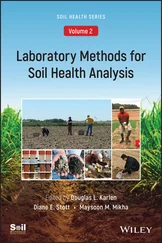Analytical Methods for Environmental Contaminants of Emerging Concern
Здесь есть возможность читать онлайн «Analytical Methods for Environmental Contaminants of Emerging Concern» — ознакомительный отрывок электронной книги совершенно бесплатно, а после прочтения отрывка купить полную версию. В некоторых случаях можно слушать аудио, скачать через торрент в формате fb2 и присутствует краткое содержание. Жанр: unrecognised, на английском языке. Описание произведения, (предисловие) а так же отзывы посетителей доступны на портале библиотеки ЛибКат.
- Название:Analytical Methods for Environmental Contaminants of Emerging Concern
- Автор:
- Жанр:
- Год:неизвестен
- ISBN:нет данных
- Рейтинг книги:5 / 5. Голосов: 1
-
Избранное:Добавить в избранное
- Отзывы:
-
Ваша оценка:
- 100
- 1
- 2
- 3
- 4
- 5
Analytical Methods for Environmental Contaminants of Emerging Concern: краткое содержание, описание и аннотация
Предлагаем к чтению аннотацию, описание, краткое содержание или предисловие (зависит от того, что написал сам автор книги «Analytical Methods for Environmental Contaminants of Emerging Concern»). Если вы не нашли необходимую информацию о книге — напишите в комментариях, мы постараемся отыскать её.
Provides the analytical methodology required to detect different families of organic compounds of emerging concern (CECs) from environmental samples Analytical Methods for Environmental Contaminants of Emerging Concern
Analytical Methods for Environmental Contaminants of Emerging Concern
Analytical Methods for Environmental Contaminants of Emerging Concern — читать онлайн ознакомительный отрывок
Ниже представлен текст книги, разбитый по страницам. Система сохранения места последней прочитанной страницы, позволяет с удобством читать онлайн бесплатно книгу «Analytical Methods for Environmental Contaminants of Emerging Concern», без необходимости каждый раз заново искать на чём Вы остановились. Поставьте закладку, и сможете в любой момент перейти на страницу, на которой закончили чтение.
Интервал:
Закладка:
| Analytes | Matrix | Analytical method | Analysis conditions | |
| 156 target analytes screened120 satisfactorily determined71 and 73 compounds quantified | Wastewater and receiving waters in South Africa | UHPLC-Orbitrap MSESIOrbitrap analyser | Analytical column:XBridge™ C18, 100 mm × 2.1 mm, 3.5 μm Mobile phase:[A] 0.1% formic acid in water and [B] 0.1% formic acid in acetonitrile Elution programme: 0–2% B, progressed to 98% B in 15 minutes, then a hold in 2 minutes, and returned to the initial conditions | [100] |
| 17-α-ethynylestradiol [EE2], 17-β-estradiol [E2], estrone [E1], testosterone, progesterone, diclofenac, primidone | Tropical estuarine sediments | LC-MS/MSESI[+]/[−] modesTriple quadrupole analyser | Analytical column:Kinetex XB C18, 30 mm × 2.1 mm, 1.7 μm Mobile phase: for negative ionization mode [A] 0.2% NH 4OH in 95% water [95 : 5, H 2O:OS] [OS consists of 60% methanol and 40% acetonitrile] and [B] 0.2% NH 4OH in 95% OS [95 : 5, OS: H 2O]. for positive ionization mode [A] 95% water [95 : 5, H 2O:OS] [OS] and [B] 95% OS [95 : 5, OS: H 2O]. Elution programme: for negative ionization mode 0 – 3 minutes 5% B progressed to 95% in 4 minutes and then holding it constant for 2 minutes and returned to the initial conditions for positive ionization mode 0–3 minutes 5% B progressed to 95% in 3 minutes and then holding it constant for 2 minutes and returned to the initial conditions | [89] |
| Ceftazidime, meropenem, amoxicillinCiprofloxacin, lincomycin, clindamycin, erythromycin, azithromycin, clarithromycin, tylosin, sulfamethazine, sulfamethoxazole, trimethoprim, tetracycline, minocyclinechlortetracycline, oxytetracyclinetriclosan, triclocarban, vancomycinchloramphenicol | Environmental water samples [surface water, treated wastewater effluents] | UHPLC -MS/MSESI [+]/[−] modesTriple quadrupole analyser | Analytical column:Poroshell 120EC-C18, 100 mm × 3.0 mm, 2.7 μm Mobile phase:[A] 0.1% formic acid in water and [B] 0.1% formic acid in a 50 : 50 [v/v] mixture of methanol and acetonitrile Elution programme: 0–1.5 minutes 10% B progressed to 90% B at 15 minutes, held until 22 minutes, and returned to the initial conditions | [87] |
| 40 multiclass antibiotics from cephalosporin, fluoroquinolone, lincosamide, macrolide,nitroimidazole, quinolone, sulfonamide and tetracycline groups | Environmental matrices | LC-MS/MSIon source: ESITriple quadrupole/linear ion trap analyser | Analytical column:Kinetex C18, 100 mm × 2.1 mm, 2.6 μm Mobile phase:[A] 0.001% formic acid in water and [B] methanol Elution programme: 0–0.01 minutes 5% B progressed to 10% B at 3.0 minutes, then to 28% B at 6.0 minutes, 70% B at 11.0 minutes, 85% B at 13 minutes, and finally returned to the initial conditions | [88] |
| acetaminophen, acetazolamide, acetylsalicylic acid, amiodarone, amoxicillin, ampicillin, atenolol, azithromycin, caffeine, carbamazepine, ciprofloxacin, diclofenac, clarithromycin, cyclophosphamide, erythromycin A, flumequine, gemfibrozil, hydrochlorothiazide, ibuprofen, josamycin, ketoprofen, lorazepam, losartan, metoprolol, metronidazole, niflumic acid, nordiazepam, 19-norethindrone, norfloxacin, ofloxacin, oxazepam, oxolinic acid, phenazone, piperacillin, roxithromycin, spiramycin, sulfadiazine, sulfamethazine, tylosine sulfamethoxazole, tetracycline, trimethoprim | Three fish species hake [ Merluccius merluccius ], red mullet [ Mullus surmuletus ], sole [ Solea solea ] and one crustacean species shrimp [ Palaemon serratus ] | UPLC-MS/MSIon source: ESI[+]/[−]Triple quadrupole analyser | Analytical column:C18 Acquity UPLC HSS T3, 50 mm × 2.1 mm, 1.8 μm Mobile phase: for positive ionization mode [A] 0.1% formic acid in water and [B] acetonitrile for negative ionization mode [A] 0.01% formic acid and eluent [B] acetonitrile Elution programme: 0–2 minutes 2% [B] progressed to 60% at 4 minutes, then to 100% at 6 minutes, held 1 minute and returned to the initial conditions | [92] |
| 56 antimicrobial drugs (tetracyclines, sulfonamides,β-lactams, macrolides and quinolones) | Wastewater and sea water | UPLC-MS/MSIon source: ESI[+]Triple quadrupole analyser | Analytical column:ACQUITY UPLC®BEH C18 column [100 mm × 2.1 mm] with a 1.7 μm particle size Mobile phase:[A] 0.1% formic acid in water and [B] acetonitrile Elution programme: 0 minutes – 1% B at progressed to 99% B at 10 minutes and then returned to the initial conditions | [95] |
List of abbreviations: ACN: acetonitrile; dSPE: dispersive solid-phase extraction; ESI: electrospray ionization; EtOAc: ethylacetate; FA: formic acid; FUSLE: focused ultrasonic solid-liquid extraction, HPLC: high-performance liquid chromatography; HRMS: high-resolution mass spectrometry; LCL: lowest calibrated level; LLE: liquid-liquid extraction; MAE: microwave-assisted extraction; MDL: method detection limit; MQL: method quantification limit; MRM: multiple reaction monitoring; MS: mass spectrometry; MS/MS: tandem mass spectrometry; NSAIDs: non-steroidal anti-inflammatory drugs; SIM: selected ion monitoring; SPE: solid-phase extraction; SRM: selected reaction monitoring; UAE: ultrasound-assisted extraction; UPLC: ultra-performance liquid chromatography; UV: ultraviolet light.
2.4 Conclusion and Future Trends
Despite the undoubtedly impressive development of research methodologies that has been made, there are still numerous methodological challenges to overcome. Isolation and pre-concentration of analytes remains a key step in environmental analysis. Significant dilution of pharmaceuticals in seawater samples and condensation of contaminants in wastewater require modification of existing SPE procedures. Furthermore, most SPE sorbents are disposable, which is costly and contrary to the principles of green analytical chemistry. Therefore, the development of suitable sample preparation methods that fit within the principles of green analytical chemistry remains a necessary and challenging task. Alternative sampling methods, such as composite samples or passive samplers, can provide a more representative chemical profile. In addition, an inappropriate extraction method can affect matrix effects, which are indicated as a major problem in the analysis of trace pharmaceuticals using the LC/MS technique. Matrix effects can limit the usefulness of coupled techniques in quantitative analysis, especially when performing compound determinations in environmental, food, wastewater or biological samples. Typically, suppression or enhancement of the analyte response is accompanied by reduced precision and accuracy of subsequent measurements. Various ways to reduce the influence of matrix components, including the use of isotopically labelled standards, changes in mass spectrometer operating conditions and chromatographic conditions, and modifications to the sample extraction procedure can be used [31]. If matrix effects cannot be minimized sufficiently, appropriate calibration techniques to determine matrix effect values are currently in practice. Further work in this area should be carried out and, in particular, standardisation of methodologies should be attempted.
In recent years, the performance of LC instrumentation, in particular HRMS, has increased, and other tools, e.g. HILIC and IMS, have been recognized as promising additions for the analysis of difficult compounds. It is also necessary to carry out research primarily aimed at the identification of a broad spectrum of pharmaceuticals, including the use of non-target and suspect screening approaches. Many different data processing strategies have been developed in recent years. However, structure elucidation remains a difficult and time-consuming task. In the future, it is likely that data processing and software capabilities will increase, enabling approaches to process large amounts of data. The reproducibility and comparability of non-target and suspect screening is already being discussed and should become an important research topic in the near future.
Читать дальшеИнтервал:
Закладка:
Похожие книги на «Analytical Methods for Environmental Contaminants of Emerging Concern»
Представляем Вашему вниманию похожие книги на «Analytical Methods for Environmental Contaminants of Emerging Concern» списком для выбора. Мы отобрали схожую по названию и смыслу литературу в надежде предоставить читателям больше вариантов отыскать новые, интересные, ещё непрочитанные произведения.
Обсуждение, отзывы о книге «Analytical Methods for Environmental Contaminants of Emerging Concern» и просто собственные мнения читателей. Оставьте ваши комментарии, напишите, что Вы думаете о произведении, его смысле или главных героях. Укажите что конкретно понравилось, а что нет, и почему Вы так считаете.












